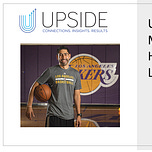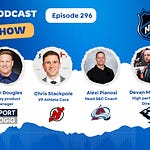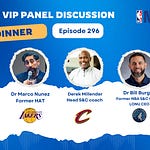This week we had the honor to interview Marco Nunez, the former Head Athletic Trainer for the LA Lakers (NBA). Marco worked for the LA Lakers for 12 years with world’s class athletes like Kobe Bryant, Shaq or Lebron James.
📝 Show Notes: Through this interview, we touched on his background, the evolution of the role of athletic trainer, what it was like to work for a top team like the LA Lakers. We also discussed his transition from working for a pro team to having his own business and his own clients. Marco also gave his advice to any athletic trainers, or performance coaches looking to have his/her own business after working in the world of elite sports.
Best Quotes: Here’s some of the key discussion points and best quotes from our conversation with Marco:
On the role of athletic trainer and the evolution of this role in the past years:
“ Our role has been traditionally about the immediate care of the athlete. It also includes some rehabilitation and also injury prevention. So that's the traditional role of athletic training. And I decided that I didn't want to be that traditional athletic trainer, which is where he or she just stayed in the athletic training room. I was watching strength coaches transition from the old traditional strength coach type role to performance coaches”.
“PT physical therapists also started to transition into performance type roles. So my question was: Why can't I, as an athletic trainer, do the same thing? I mean, we're kind of in the same realm. I understood that I had my CSCs. I was certified. I had taken plenty of classes to allow me to become a corrective exercise specialist and performance enhancement specialist”.
On the Golden State Warriors becoming the first NBA team to hire a sports scientist which impacted the role of athletic trainers over time:
“One of the biggest things which was a shocker to the people in the league itself started maybe about 15 years ago. And one of my good friends, JoHan Wang, who was the head athletic trainer for the Golden State Warriors, became a little bit, I don't wanna say victim of it, but got caught in it. This whole sports science sports science space blew up which is why I think the Golden State Warriors were one of the first NBA teams to bring in a sports scientist from Australia. And Australia was one of the leading countries to introduce sports science, with wearable devices like Catapult. They were leading the way”.
“So Golden State brought him in and I think they won a championship. And then every NBA teams said “we got to get one too”. And then teams started bringing in a sports scientist. The head athletic trainer, which was normally in charge of everything, started going down the totem pole. And at the time I wasn't a head athletic trainer but I was an assistant head athletic trainer”.
“So I thought to myself. I need to get in the game. I need to expand my expertise. I cannot just be the athletic trainer. So that's when I decided that I needed to go into performance training and prevention and learn about rehab sports science, wearable devices and so on. So I expanded my role and skills. So I taught myself and I'll be honest, there is no formal title to performance athletic trainer which is what I became”.
On what it was like to work for a top team like the LA Lakers:
“When it comes to working with professional teams, there is no balance when it comes to work life or family. Unfortunately it is what it is. But the one thing I did notice is that my role or my work-life balance completely changed when I went from the assistant athletic trainer to the head athletic trainer. I became the person simply in charge of everything as opposed to when I was the assistant athletic trainer, where I still had a little bit of freedom. But as the head athletic trainer, you have to make yourself accessible on the phone and you have to be able to take calls whenever you can 24 hours, 7 days a week”.
“And it also varies slightly from team to team. You have some high profile teams, like the Lakers, the Dallas Cowboys, the New York Yankees, or the Pittsburgh penguins, where the spotlight is on you”.
And there seems to be a little more of a hot seat on those high profile teams. If you've got the best player in the league, that's a pretty hot seat right there. And you have to do anything that you need to do to try to be able to maintain the players’ health and do it because not only is the front office expecting you to keep him or her healthy, but then now you have the media and you have everybody outside looking at you”.
On his transition from working for a pro team to having his own business and his own clients:
“Once I received the head athletic trainer position at the LA Lakers, I decided that I wanted to stay in this position only for maybe three to five years. I had no interest in staying longer than that. I knew Gary Vitti, the former head athletic trainer that came before me, was there for 32 years. So I was already planning to be in my next life after sports or professional sports”.
“I've seen PTs doing a business platform where you have clinics everywhere you go. You also have strength coaches, but you really don't have athletic training rooms all. You have performance, strength, coaches at places like Equinox, and then you have PT clinics, but you don't really see athletic training rooms anywhere”.
“And I think I'm glad that I saw this 10 years before I had my strength coach CSEs. I can now do recovery. I also noticed that a lot of NBA athletes have their own guy or their own person that takes care of them because they understand “Hey, this is my body. I have a team, a sports medicine team at the facility at the organization, but they're not with me the whole time so I need somebody. So I was thinking: how can I kind of continue on that part?”.
“So I now choose who I want to work with. Yes, it is tough when you have a client calling you and say: Hey mark, can you come work with me from 4:00 PM to 6:00 PM and evening? And I might say “I cannot because I have to do something with my kids, my wife or family”.
On the type of clients he works with:
“My clients range from 11 years old to about 50 years old. And the majority of the clients that I work with are some that I worked with before. There are several professional athletes that I work with that are currently with a professional team in the NFL and NBA”.
“I also work with some older population. They were athletes themselves before and now they have issues or injuries. They played college football, so their shoulders has been bugging them forever, but they still want to work out. They still want to be active. So I can help them there”.
“To be honest, I also enjoy working with the young athletes because I help build a foundation for them. So when they get to that next level, it helps them out”.
On what it is like for him to run his own business:
“I'm still learning and I don't think I've ever stopped learning. I've listened to other podcasts. I listen to audio books on business, branding, marketing, social media, or finance. I also listen to podcasts on" how to spend money, how to get your most bang for your buck. For example something as simple as doing social media. Do I want to boost this post that I just did?”.
“As a startup, it's tough because you have to do it yourself at some point, either you have to hire somebody to help you to take it to the next level. So there's a little balance there. Everyone has to figure it out on his/her own. At what point do I need to bring somebody in to help me or can I still manage it myself type of thing”? is the question”.
On his advice to any athletic trainers looking to transition out of the world of elite sports:
“When I talk to other athletic trainers, they sometimes want to get out, but they're scared because they don't see anything beyond that. And the reason being is that as an athletic trainer, that's been the traditional role, working for a team, working for a college, or working at a high school”.
“And I will tell you, there is life after or outside the athletic training room. Yes. It's a little grind. There's a lot of grinders. You have to put your grind in there as well, because if you're willing to put in the grind, there is life. But I'm sure at the beginning of the first few months, it is not always easy, but once you find your rhythm, you find your customer base”.
“For example, for myself, when I opened up my own business, my LLC it was in 2016 right when I took over as a head athletic trainer. And the reason why I did that is because I knew that I wanted to eventually get out”.
“I was already thinking three to five years ahead. I opened my business. So I thought: Let me slowly start getting that ball rolling. I knew that I didn't have too much time to fully dive into it because I was working for the Lakers. That was my priority, but on the side, and in the evenings at night time I was thinking “Okay. What can I do to start building it and get it rolling?”.
“So if you are looking for life after working for pro teams, you can start now by slowly building up to it and then you can see where it can slowly take you so that when you do leave, you're not necessarily starting from scratch”.
You may also like:
🔥Upside Chat: Alexi Pianosi, Strengths and Conditioning Coach, Pittsburgh Penguins (NHL)
🔥Upside Chat: Pierre Barrieu, High Performance Director, Toronto FC (MLS)











